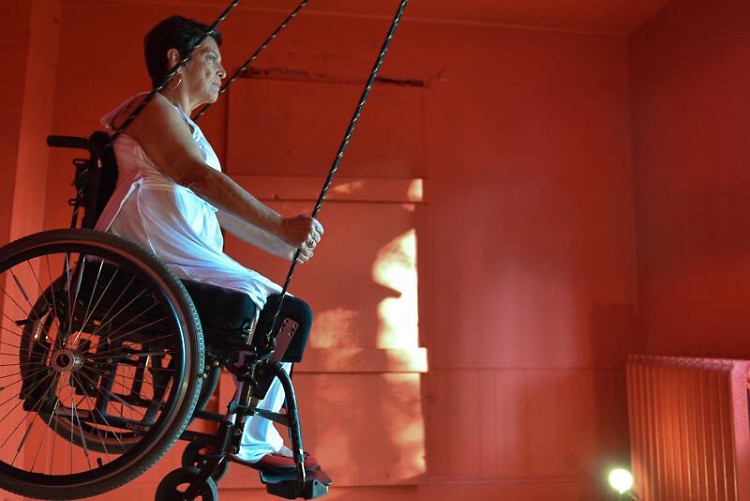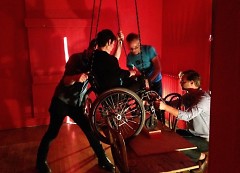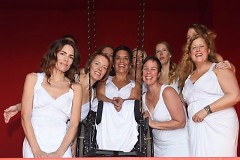Late into a night of celebrating at SiTE:LAB on Friday after the ArtPrize Awards Ceremony, members of the team of volunteers animatedly discussed how to retrofit a swing to accommodate long-time volunteer Toni Bal. Bal is in a wheelchair as a long-term result of polio attacking and weakened her body as a child.
A local writer and former teacher for decades in the Grand Rapids Public School system, Bal has become an important part not only of the tight core of SiTE:LAB volunteers, but a barometer for their success as well. So as the “ladies of SiTE:LAB” planned to take over the juried grand prize winner, Kate Gilmore’s “Higher Ground,” for the last hour of ArtPrize - Sunday at 5- they just didn’t feel right about not having Toni swinging with them.
So they set to work. At the end of the marathon that is ArtPrize, the true test of the community was met as they took on one more challenge. Multiple plans were laid out, and passed over.
Laura Amenta, an occupational therapist who is used to adapting environments or objects to allow participation, says she knew they would be able to pull it off.
“We felt all along that it should be possible to adapt the swing in some way shape or form so she could participate alongside us,” she says, echoing the sentiment of others on the team, who say they often measure the success of their work at SiTE:LAB with the question “Can Toni participate.”
Even on Sunday, though, Bal herself wasn’t sure she wanted to do it.
“I said yes, I said no, I said yes…” she says. “But then they started talking about how they were going to attach it [to my wheelchair] in four places, and I said that’s better than customizing a swing- and that’s when I said yes.”
Bal, who remembers swinging as one of her favorite activities as a child, was surprised at the experience as an adult.
“I wasn’t worried at all about the strength of the ropes and being suspended like an actual swing. I wasn’t really worried about anything, which surprised me,” she says. “But as the hour went by… It was like swimming… I just completely emptied my mind.”
The performance piece has received flak from some for winning, as many who didn’t see it in person compare it to John Mellencamp’s “Little Pink Houses” and other references to how easy it is to paint a house pink and win the prize, rather than seeing or understanding the full performance aspects of the work.
Even Bal, SiTE:LAB’s champion to the end, says watching the performance in person is necessary to fully appreciating the artwork.
“It doesn’t look like a really friendly space with the pepto bismol pink and the red interior. It kind of looks off-putting. But then you see white dresses and red shoed feet coming out of windows, and you wonder- what is that? That was my first reaction to it as I saw it from afar,” says Bal. “And now that I’ve had the swinging experience, it’s one of the most peaceful environments I’ve ever been in, let alone participated in. The act of swinging itself is extremely peaceful.”
Having Bal participate seemed like the perfect fit, Amenta says, as she sees the work’s statement on female empowerment.
“To me, Kate [Gilmore]’s artwork is about women breaking through barriers, crossing thresholds both literally and figuratively,” says Amenta. “Toni has done this in so many ways. She is fierce and bold and that is what we love about her!”
That love and dedication- evident not only towards the artwork within SiTE:LAB but so often toward one another- may be just the reason that their hard work pays off so often. Inclusion, it turns out, comes most authentically when it is born of real relationships. Our culture isn't used to forming communities as closely-knit as SiTE:LAB has somehow managed to create.
But imagine the challenges we could meet together if we did.
Disclosure: Holly Bechiri is a friend of Toni Bal's, and others at SiTE:LAB.
The Rapidian, a program of the 501(c)3 nonprofit Community Media Center, relies on the community’s support to help cover the cost of training reporters and publishing content.
We need your help.
If each of our readers and content creators who values this community platform help support its creation and maintenance, The Rapidian can continue to educate and facilitate a conversation around issues for years to come.
Please support The Rapidian and make a contribution today.


